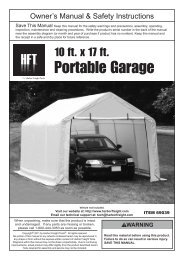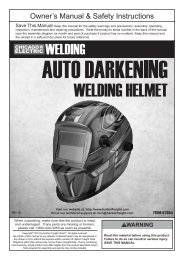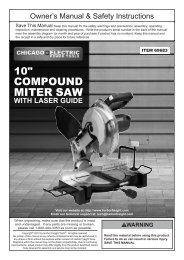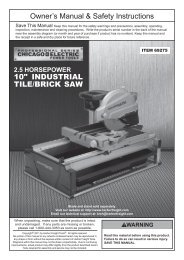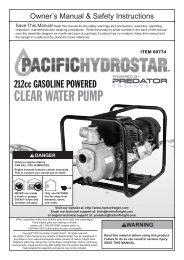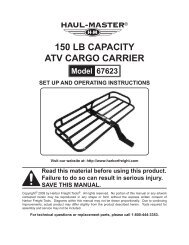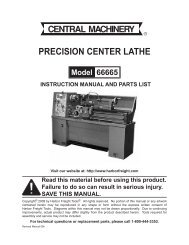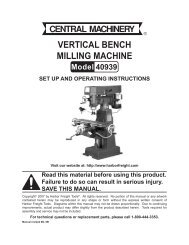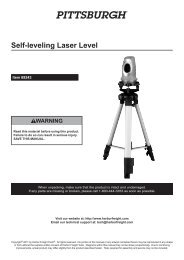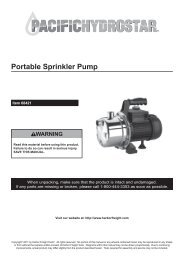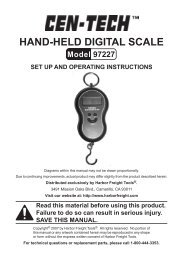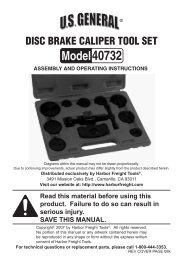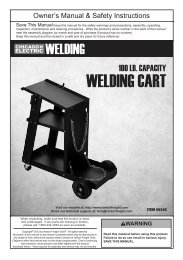Inspection - Harbor Freight Tools
Inspection - Harbor Freight Tools
Inspection - Harbor Freight Tools
You also want an ePaper? Increase the reach of your titles
YUMPU automatically turns print PDFs into web optimized ePapers that Google loves.
Table of Contents<br />
SAFETY SETUP<br />
OPERATION INSPECTION<br />
Safety.......................................................... 3<br />
Specifications.............................................. 4<br />
Setup........................................................... 4<br />
Operation..................................................... 5<br />
WARNING SYMBOLS AND DEFINITIONS<br />
<strong>Inspection</strong>.................................................... 8<br />
Parts List and Diagram............................... 11<br />
Warranty..................................................... 12<br />
This is the safety alert symbol. It is used to alert you to potential personal injury hazards.<br />
Obey all safety messages that follow this symbol to avoid possible injury or death.<br />
Indicates a hazardous situation which, if not avoided,<br />
will result in death or serious injury.<br />
Indicates a hazardous situation which, if not avoided,<br />
could result in death or serious injury.<br />
Indicates a hazardous situation which, if not avoided,<br />
could result in minor or moderate injury.<br />
Addresses practices not related to personal injury.<br />
Page 2 For technical questions, please call 1-800-444-3353. Item 69854<br />
69855
IMPORTANT SAFETY INFORMATION<br />
TO PREVENT SERIOUS INJURY AND DEATH:<br />
Basic Safety Information<br />
1. Do not pull more than rated load. Be aware of<br />
dynamic loading! Sudden load movement may<br />
briefly create excess load causing product failure.<br />
2. Do not operate while puller restricted from<br />
forming a straight line with loading direction.<br />
3. Do not operate puller with twisted, kinked, or<br />
damaged wire rope.<br />
Inspect wire rope carefully before every use.<br />
4. Do not operate a damaged or malfunctioning<br />
puller. Inspect puller carefully and<br />
test operation before every use.<br />
5. Do not use for vertical lifting.<br />
Do not lift people or lift loads over people.<br />
Falling loads can injure or kill people.<br />
Setup Specific Safety Information<br />
1. The supporting structure the puller is mounted<br />
to must be designed to withstand the loads and<br />
forces imposed by the puller for the rated load.<br />
6. Do not operate puller with a lever extension.<br />
7. Do not operate with rope not<br />
centered in its groove.<br />
8. Do not remove or cover warning labels and/<br />
or tags. These carry important safety information.<br />
If unreadable or missing, contact<br />
<strong>Harbor</strong> <strong>Freight</strong> <strong>Tools</strong> for a replacement.<br />
9. The warnings, precautions, and instructions<br />
discussed in this instruction manual cannot<br />
cover all possible conditions and situations<br />
that may occur. It must be understood by the<br />
operator that common sense and caution are<br />
factors which cannot be built into this product,<br />
but must be supplied by the operator.<br />
2. Install in location that allows the operator<br />
to move and stay clear of the load.<br />
3. Inspect the puller as explained in Frequent <strong>Inspection</strong><br />
on page 8 after setup but before use.<br />
<strong>Inspection</strong>, Testing, and Maintenance Specific Safety Information<br />
1. Perform a “Frequent <strong>Inspection</strong>”<br />
at least monthly, see page 8.<br />
2. Perform a “Periodic (Thorough) <strong>Inspection</strong>”<br />
at least yearly, see page 9.<br />
Operation Specific Safety Information<br />
1. Wear ANSI-approved safety goggles,<br />
ANSI‐approved hard hat, and<br />
steel‐toed work boots during setup and use.<br />
2. This product is not a toy.<br />
Do not allow children to play with or near this item.<br />
3. More frequent inspections are needed<br />
for pullers that are used heavily.<br />
4. Raise test loads only to the minimum extent needed<br />
and stay well clear of load at all times during testing.<br />
3. Use as intended only.<br />
• Do not use to handle molten material.<br />
• Do not use for aircraft purposes.<br />
• Do not use to link towed vehicles.<br />
4. Keep hands clear of moving parts.<br />
SAVE THESE INSTRUCTIONS.<br />
SAFETY<br />
INSPECTION OPERATION<br />
SETUP<br />
Item 69854<br />
69855<br />
For technical questions, please call 1-800-444-3353.<br />
Page 3
Specifications<br />
SAFETY SETUP<br />
OPERATION INSPECTION<br />
Setup Instructions<br />
Model 69854 69855<br />
Rated Capacity 4,000 lb.<br />
8,000 lb. double line<br />
4,000 lb. single line<br />
Maximum Extension 6.75′<br />
6′ double line<br />
10′ single line<br />
Read the ENTIRE IMPORTANT SAFETY INFORMATION section at the beginning of this<br />
manual including all text under subheadings therein before set up or use of this product.<br />
Note: For additional information regarding the parts listed in the following pages,<br />
refer to Parts List and Diagram on page 11.<br />
1. The supporting structure the puller is mounted to<br />
(including trolley, monorail, or crane)<br />
must be designed to withstand the loads and<br />
forces imposed by the puller for the rated load.<br />
Figure A: Correct and incorrect<br />
anchor hook attachment<br />
2. Properly seat the anchor hook on the supporting<br />
structure at its intended load bearing point<br />
(see the left side diagram of Figure A).<br />
Do not allow the hook hitch<br />
to support any part of the load.<br />
Do not apply the load to the point of the hook<br />
(shown in Figure A on the right side diagram).<br />
Page 4 For technical questions, please call 1-800-444-3353. Item 69854<br />
69855
Operation Instructions<br />
Read the ENTIRE IMPORTANT SAFETY INFORMATION section at the beginning of this<br />
manual including all text under subheadings therein before set up or use of this product.<br />
TO PREVENT SERIOUS INJURY: Operation of a puller involves more than pulling the lever.<br />
The use of pullers is subject to certain hazards that cannot be met by mechanical means,<br />
but only by the exercise of intelligence, care, common sense, and experience in<br />
anticipating the motions that will occur as a result of operating the controls.<br />
SAFETY<br />
Do not use this tool for vertical lifting.<br />
Before Operating Puller<br />
1. Familiarize yourself with all operating controls<br />
of the puller and with the operation(s) to be<br />
performed. Instructions include, the warnings<br />
on the puller, and the safety and operating<br />
instructions portion of this manual.<br />
2. WARNING! TO PREVENT SERIOUS INJURY<br />
FROM PULLER FAILURE:<br />
Do not use damaged equipment.<br />
If adjustments or repairs are necessary,<br />
or any defects are known, have the<br />
problem corrected before further use.<br />
3. Do not operate a puller with an out-of-order sign.<br />
Operating Controls<br />
Anchor<br />
Hook<br />
Ratchet<br />
Stop Pawl<br />
Trigger<br />
(hidden)<br />
Drive<br />
Pawl<br />
Guard<br />
Figure B<br />
4. Only a qualified technician should<br />
perform maintenance to the puller.<br />
5. Do not use the wire rope as a ground for welding.<br />
Do not touch a welding electrode to the wire rope.<br />
6. Designate a work area that is clean and well‐lit.<br />
The work area must not allow access by children<br />
or pets to prevent distraction and injury.<br />
7. There must not be objects, such as utility lines,<br />
nearby that will present a hazard while working.<br />
8. Inspect the puller as explained in Frequent <strong>Inspection</strong><br />
on page 8 after setup but before use.<br />
Pawl<br />
Spring<br />
End Hook<br />
(item 69855 only)<br />
Lever<br />
Wire<br />
Rope<br />
Pulley<br />
Hook<br />
INSPECTION OPERATION<br />
SETUP<br />
Item 69854<br />
69855<br />
For technical questions, please call 1-800-444-3353.<br />
Page 5
SAFETY SETUP<br />
OPERATION INSPECTION<br />
Applying the Load<br />
1. The 69855 puller is designed for<br />
single or double line pulls.<br />
a. A single line pull can reach twice as far and retract<br />
twice as fast, but it has half the weight capacity.<br />
b. To do a single line pull, unhook the<br />
wire rope end hook and use it as the load hook.<br />
c. For double line pulls, attach the end hook<br />
to the puller’s frame as shown in Figure B,<br />
and use the pulley hook as the load hook.<br />
6. Swing the Handle away from the<br />
Anchor Hook to expose the Drive Pawl.<br />
Ratchet<br />
Drive Pawl<br />
disengaged<br />
Figure C: Drive Pawl Operation<br />
engaged<br />
Pawl<br />
Spring<br />
7. Slide the Pawl Spring up to the disengaged position.<br />
The Drive Pawl will be held clear of the Ratchet.<br />
Anchor Hook<br />
Stop Pawl<br />
Trigger<br />
Stop Pawl Trigger<br />
Ratchet<br />
Figure D: Releasing the Stop Pawl<br />
Load/Pulley<br />
Hook<br />
8. Squeeze the Stop Pawl Trigger as shown above.<br />
9. Pull the wire rope out to reach the load.<br />
10. Release the Stop Pawl Trigger.<br />
11. Do not wrap the puller wire rope around the load.<br />
12. Attach the load to the load hook securely by<br />
properly rated, suitable means, such as chains,<br />
shackles, hooks, lifting slings, etc. Load must be<br />
attached to prevent accidental disconnection.<br />
Figure E: Correct and incorrect<br />
load hook attachment<br />
13. Properly seat the sling or other device<br />
in the base (bowl or saddle) of the hook<br />
(see the left side diagram on Figure E). Do not<br />
allow the hook hitch to support any part of the load.<br />
14. Do not apply the load to the point of the hook<br />
(shown in Figure E on the right side diagram).<br />
15. Before moving the load, make sure wire rope is<br />
not kinked or twisted or that multiple part wire<br />
ropes are not twisted around each other.<br />
16. Do not operate the puller unless wire rope is seated<br />
properly on the drum, pulleys, or sprockets.<br />
17. Do not pick up a load in excess of the rated<br />
load appearing on the puller or load block,<br />
except during properly authorized tests.<br />
Do not use a puller overload limiting device to<br />
measure the maximum load to be pulled.<br />
18. Give specific attention to load balancing and<br />
hitching or slinging to prevent load slipping.<br />
Page 6 For technical questions, please call 1-800-444-3353. Item 69854<br />
69855
Moving the Load<br />
1. Slide the Pawl Spring down to the engaged position,<br />
as shown in Figure C. The Drive Pawl<br />
will be pressed against the Ratchet.<br />
2. Do not engage in any activity which will divert the<br />
operator’s attention while operating the puller.<br />
3. Respond to signals from a designated person only.<br />
However, always obey a stop signal,<br />
no matter who gives it.<br />
4. Do not move a load with the puller until the operator<br />
and all other personnel are clear of the load.<br />
5. Make sure the load and puller will clear all<br />
obstacles before moving or rotating the load.<br />
6. Do not move a load more than a few inches until<br />
it is well balanced in the sling or pulling device.<br />
7. Each time a load approaching rated capacity is<br />
handled, check puller brake action by pulling the<br />
load just clear of supports and continuing only after<br />
verifying that the brake system is operating properly.<br />
8. WARNING! Do not carry any<br />
load over any person.<br />
9. WARNING! Do not carry personnel<br />
on the hook or the load.<br />
10. Pull the Handle toward the Anchor side<br />
of the Puller. This will pull the Load.<br />
11. Swing the Handle back and forth until the load<br />
has been pulled to the desired position.<br />
SAFETY<br />
Parking the Load<br />
1. Do not leave a supported load unattended<br />
unless specific precautions have been<br />
instituted and are in place.<br />
2. Exercise care when removing a sling from<br />
under a landed and blocked load.<br />
3. Secure the load so it will not move before<br />
releasing the tension on the wire rope.<br />
4. To release the wire rope tension:<br />
a. Swing the Handle away from the<br />
Anchor Hook to expose the Drive Pawl.<br />
b. Slide the Pawl Spring up to the<br />
disengaged position. The Drive Pawl<br />
will be held clear of the Ratchet.<br />
c. Swing the handle to the Anchor Hook side and<br />
force the spring loaded STOP PAWL pin down,<br />
then slowly raise the handle. This action will allow<br />
the wire rope drum to back off by one cam step.<br />
d. Repeat this action, as needed, until the<br />
tension on the wire rope eases.<br />
e. Pull on the STOP PAWL TRIGGER to release it<br />
from the cam and gently pull back on the tool to<br />
get wire rope slack and free it from the load.<br />
5. To prevent entangling of the wire rope onto the<br />
drum, with the Load Hook still attached to the<br />
load, push the spring into its “Down” position.<br />
Hold the Anchor hook in one hand. While gently<br />
pulling against the load, swing the Handle<br />
back and forth to rewind the wire rope.<br />
CAUTION: Do not rewind the wire rope to its end.<br />
INSPECTION OPERATION<br />
SETUP<br />
Item 69854<br />
69855<br />
For technical questions, please call 1-800-444-3353.<br />
Page 7
<strong>Inspection</strong>, Testing, and Maintenance<br />
Procedures not specifically explained in this manual must<br />
be performed only by a qualified technician.<br />
SAFETY SETUP<br />
OPERATION INSPECTION<br />
TO PREVENT SERIOUS INJURY:<br />
Remove any load before performing any inspection, maintenance, or cleaning procedures.<br />
TO PREVENT SERIOUS INJURY FROM TOOL FAILURE:<br />
Do not use damaged equipment. If abnormal noise or vibration occurs,<br />
have the problem corrected before further use.<br />
Frequent <strong>Inspection</strong><br />
Perform the procedures in this section BEFORE<br />
INITIAL USE and AT LEAST MONTHLY. <strong>Inspection</strong><br />
is needed more often for heavily used pullers.<br />
1. Check operating mechanisms for proper operation,<br />
proper adjustment, and unusual sounds<br />
such as, but not limited to, binding noise<br />
of the wire rope and bearing squeal.<br />
2. Frequent Braking System <strong>Inspection</strong><br />
a. The braking system must automatically stop and<br />
hold up to the rated load if the lever is released.<br />
3. Frequent Hook <strong>Inspection</strong><br />
Check hooks for the following problems:<br />
a. distortion, such as bending, twisting,<br />
or increased throat opening;<br />
b. wear;<br />
c. cracks, nicks, or gouges;<br />
d. latch engagement (if equipped);<br />
e. damaged or malfunctioning latch (if equipped);<br />
f. hook attachment and securing means.<br />
4. Frequent Puller Rope <strong>Inspection</strong><br />
All ropes should be visually inspected by the operator<br />
or other designated person at the start of each shift.<br />
These visual observations should be concerned with<br />
discovering gross damage, such as listed below,<br />
which may be an immediate hazard:<br />
a. distortion of the rope such as kinking,<br />
crushing, unstranding, birdcaging,<br />
main strand displacement, or core protrusion;<br />
b. general corrosion;<br />
c. broken or cut strands;<br />
d. number, distribution, and type<br />
of visible broken wires:<br />
1) in running ropes,<br />
12 randomly distributed broken wires in one lay<br />
or four broken wires in one strand in one lay;<br />
2) one outer wire broken at the contact point<br />
with the core of the rope which has worked its<br />
way out of the rope structure and protrudes<br />
or loops out from the rope structure.<br />
If such damage is discovered, either remove the rope<br />
from service or arrange for a qualified technician<br />
to give it a periodic (thorough) inspection.<br />
5. Check wire rope reeving.<br />
6. Check puller lever for bends,<br />
cracks, or other damage.<br />
7. Check for damage to the support for the puller.<br />
WARNING! TO PREVENT SERIOUS INJURY FROM PULLER FAILURE: Do not use damaged equipment.<br />
If any defect or damage is noted, have the problem corrected before further use.<br />
Page 8 For technical questions, please call 1-800-444-3353. Item 69854<br />
69855
Periodic (Thorough) <strong>Inspection</strong><br />
A qualified technician should perform the procedures<br />
in this section AT LEAST YEARLY. <strong>Inspection</strong> is<br />
needed more often for heavily used pullers.<br />
Remove or open access covers to allow<br />
inspection of components.<br />
1. First, follow all Frequent <strong>Inspection</strong> procedures.<br />
Additionally:<br />
2. Check fasteners for evidence of loosening.<br />
3. Check load blocks, suspension housings,<br />
levers, clevises, yokes, suspension bolts,<br />
shafts, gears, bearings, pins, rollers, and<br />
locking and clamping devices for evidence of<br />
wear, corrosion, cracks, and distortion.<br />
4. Check hook retaining nuts or collars, and pins,<br />
welds, or rivets used to secure the retaining<br />
members for evidence of damage.<br />
5. Check load sprockets, idler sprockets, drums,<br />
and pulleys for evidence of damage and wear.<br />
6. Check the brake mechanism for evidence of<br />
worn, glazed, or oil contaminated friction disks;<br />
worn pawls, cams, or ratchets;<br />
and corroded, stretched, or broken pawl springs.<br />
7. Check supporting structure or trolley,<br />
if used, for evidence of damage.<br />
8. Check warning label for legibility and replacement.<br />
9. Check end connections of wire ropes for evidence<br />
of wear, corrosion, cracks, damage, and distortion.<br />
10. Periodic (Thorough) Puller Rope <strong>Inspection</strong><br />
Check entire length of rope puller rope as follows:<br />
Inspect the individual outer wires in the strands<br />
of the rope. Keep a record of any deterioration<br />
resulting in appreciable loss of original strength,<br />
such as described below, and have a qualified<br />
technician determine whether further use<br />
of the rope would constitute a hazard:<br />
a. Check points listed in Frequent<br />
Puller Rope <strong>Inspection</strong> on page 8.<br />
b. Check for reduction of rope diameter<br />
below nominal diameter due to loss of<br />
core support, internal or external corrosion,<br />
or wear of outside wires.<br />
c. Check for severely corroded or broken<br />
wires at end connections.<br />
d. Check for severely corroded, cracked, bent,<br />
worn, or improperly applied end connections.<br />
e. Inspect with special care the following<br />
sections of rapid deterioration:<br />
1) sections in contact with saddles,<br />
equalizer pulleys, or other pulleys<br />
where rope travel is limited;<br />
2) sections of the rope at or near terminal ends<br />
where corroded or broken wires may protrude;<br />
3) sections subject to reverse bends;<br />
4) sections of rope which are normally<br />
hidden during visual inspection, such<br />
as parts passing over pulleys.<br />
11. Check the puller and puller mounting<br />
for evidence of missing parts.<br />
WARNING! TO PREVENT SERIOUS INJURY FROM PULLER FAILURE: Do not use damaged equipment.<br />
If any defect or damage is noted, have the problem corrected before further use.<br />
SAFETY<br />
INSPECTION OPERATION<br />
SETUP<br />
Item 69854<br />
69855<br />
For technical questions, please call 1-800-444-3353.<br />
Page 9
Storage <strong>Inspection</strong><br />
SAFETY SETUP<br />
OPERATION INSPECTION<br />
1. A puller that has been idle for a period<br />
of a month or more, but less than a year,<br />
must be inspected before being used according<br />
to the Frequent <strong>Inspection</strong> requirements.<br />
Maintenance<br />
1. Repair or replacement of puller components must be<br />
performed only by a qualified technician using only<br />
identical replacement parts with the same rating.<br />
2. Operating mechanisms, pawls, and<br />
brakes may require adjustment.<br />
3. Note the following regarding specific components:<br />
a. Replace damaged or worn hooks. Do not repair<br />
them by welding or reshaping.<br />
b. Replace excessively worn braking components<br />
such as friction disks, ratchets,<br />
pawls, and pawl springs.<br />
c. Replace or repair all critical parts, including<br />
load suspension components, that are cracked,<br />
broken, bent, excessively worn, or missing.<br />
Testing<br />
1. Before use, test repaired pullers and pullers<br />
that have not been used for a year or more.<br />
2. Check all functions of the puller, including retracting<br />
and extending, with the puller unloaded first.<br />
(This puller may require a small load or pull on<br />
the load hook to test lowering/extending.)<br />
2. A puller that has been idle for a period of a<br />
year or more, must be inspected according<br />
to the Periodic <strong>Inspection</strong> requirements and<br />
then tested according to the procedure in the<br />
Testing section below before being used.<br />
d. Replace bent, cracked, or<br />
otherwise damaged levers.<br />
e. Replace missing or illegible warning labels.<br />
4. Do not repair load‐sustaining members by welding.<br />
Replace them as needed.<br />
5. Lubricate all moving parts regularly using grease.<br />
6. After maintenance work is completed and before<br />
restoring the puller to normal operation:<br />
a. reinstall guards;<br />
b. reactivate safety devices;<br />
c. remove replaced parts and loose material;<br />
d. remove maintenance equipment.<br />
3. After testing in the unloaded state,<br />
attach a 200 Ib. load and retest to check proper<br />
load control and to check brake operation.<br />
4. For the 69855 puller, test in both<br />
single and double line setups.<br />
PLEASE READ THE FOLLOWING CAREFULLY<br />
THE MANUFACTURER AND/OR DISTRIBUTOR HAS PROVIDED THE PARTS LIST AND ASSEMBLY<br />
DIAGRAM IN THIS MANUAL AS A REFERENCE TOOL ONLY. NEITHER THE MANUFACTURER OR<br />
DISTRIBUTOR MAKES ANY REPRESENTATION OR WARRANTY OF ANY KIND TO THE BUYER THAT HE<br />
OR SHE IS QUALIFIED TO MAKE ANY REPAIRS TO THE PRODUCT, OR THAT HE OR SHE IS QUALIFIED<br />
TO REPLACE ANY PARTS OF THE PRODUCT. IN FACT, THE MANUFACTURER AND/OR DISTRIBUTOR<br />
EXPRESSLY STATES THAT ALL REPAIRS AND PARTS REPLACEMENTS SHOULD BE UNDERTAKEN BY<br />
CERTIFIED AND LICENSED TECHNICIANS, AND NOT BY THE BUYER. THE BUYER ASSUMES ALL RISK<br />
AND LIABILITY ARISING OUT OF HIS OR HER REPAIRS TO THE ORIGINAL PRODUCT OR REPLACEMENT<br />
PARTS THERETO, OR ARISING OUT OF HIS OR HER SETUP OF REPLACEMENT PARTS THERETO.<br />
Record Product’s Serial Number Here:<br />
Note: If product has no serial number, record month and year of purchase instead.<br />
Note: Some parts are listed and shown for illustration purposes only,<br />
and are not available individually as replacement parts.<br />
Page 10 For technical questions, please call 1-800-444-3353. Item 69854<br />
69855
Parts List and Diagram<br />
Parts List<br />
Part Description<br />
1 Hook<br />
2 Frame<br />
3 Stop Pawl Spring<br />
4 Stop Pawl Trigger<br />
Part Description<br />
5 Ratchet<br />
6 Drive Pawl<br />
7 Guard<br />
8 Drive Pawl Spring<br />
Part Description<br />
9 Wire Rope<br />
10 Lever<br />
11 Pulley Hook<br />
12 End Hook (item 68955 only)<br />
SAFETY<br />
69854 Assembly Diagram<br />
1<br />
2 3 5 6 8 10<br />
69855 Assembly Diagram<br />
4 7 9 11<br />
10<br />
8<br />
1<br />
2 3 5 6<br />
INSPECTION OPERATION<br />
SETUP<br />
4 7 12<br />
9 11<br />
Item 69854<br />
69855<br />
For technical questions, please call 1-800-444-3353.<br />
Page 11
Limited 90 Day Warranty<br />
<strong>Harbor</strong> <strong>Freight</strong> <strong>Tools</strong> Co. makes every effort to assure that its products meet high quality and durability standards,<br />
and warrants to the original purchaser that this product is free from defects in materials and workmanship for the<br />
period of 90 days from the date of purchase. This warranty does not apply to damage due directly or indirectly,<br />
to misuse, abuse, negligence or accidents, repairs or alterations outside our facilities, criminal activity, improper<br />
setup, normal wear and tear, or to lack of maintenance. We shall in no event be liable for death, injuries to persons<br />
or property, or for incidental, contingent, special or consequential damages arising from the use of our product.<br />
Some states do not allow the exclusion or limitation of incidental or consequential damages, so the above limitation<br />
of exclusion may not apply to you. THIS WARRANTY IS EXPRESSLY IN LIEU OF ALL OTHER WARRANTIES,<br />
EXPRESS OR IMPLIED, INCLUDING THE WARRANTIES OF MERCHANTABILITY AND FITNESS.<br />
To take advantage of this warranty, the product or part must be returned to us with transportation charges<br />
prepaid. Proof of purchase date and an explanation of the complaint must accompany the merchandise.<br />
If our inspection verifies the defect, we will either repair or replace the product at our election or we may<br />
elect to refund the purchase price if we cannot readily and quickly provide you with a replacement. We will<br />
return repaired products at our expense, but if we determine there is no defect, or that the defect resulted<br />
from causes not within the scope of our warranty, then you must bear the cost of returning the product.<br />
This warranty gives you specific legal rights and you may also have other rights which vary from state to state.<br />
3491 Mission Oaks Blvd. • PO Box 6009 • Camarillo, CA 93011 • (800) 444-3353



